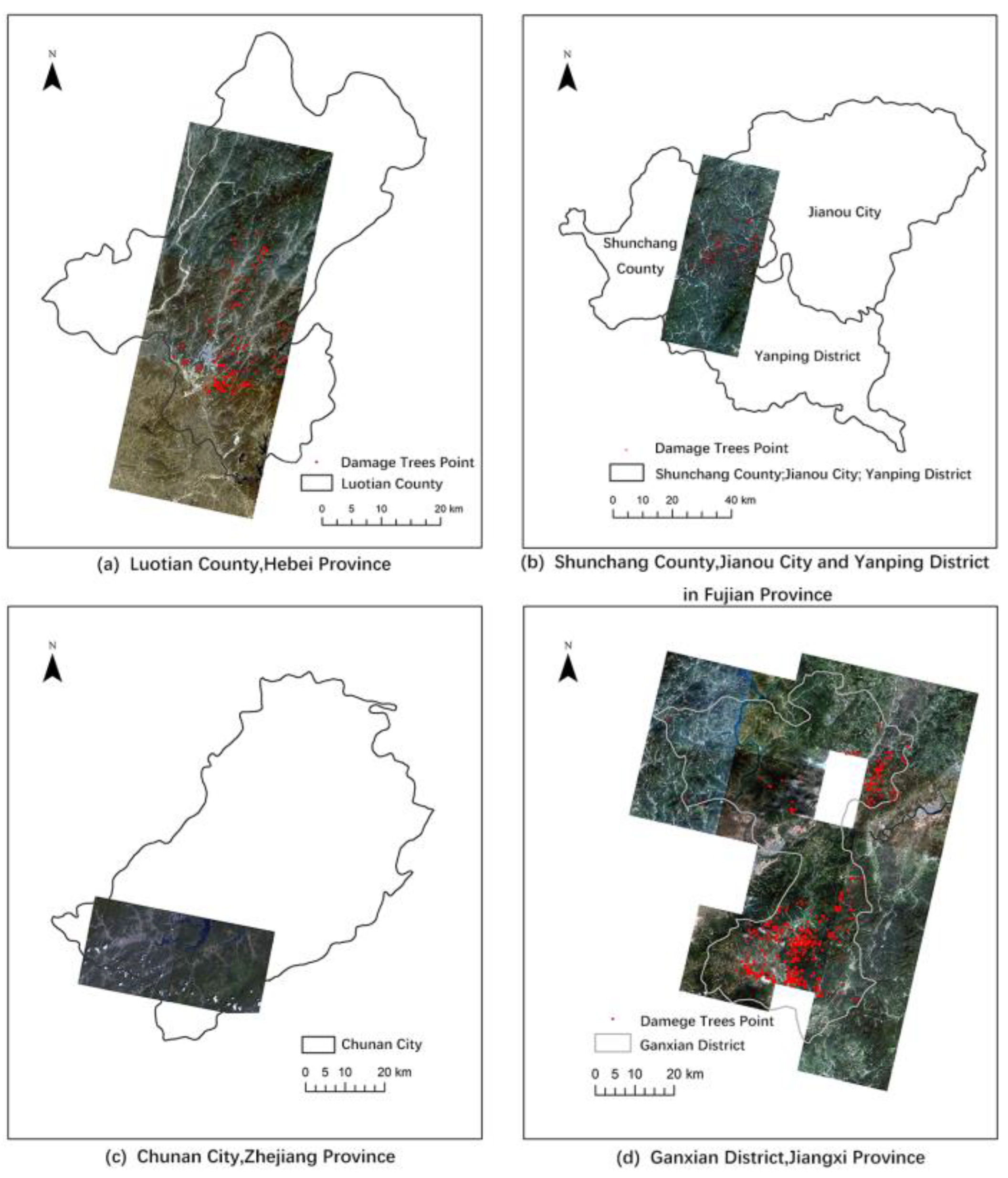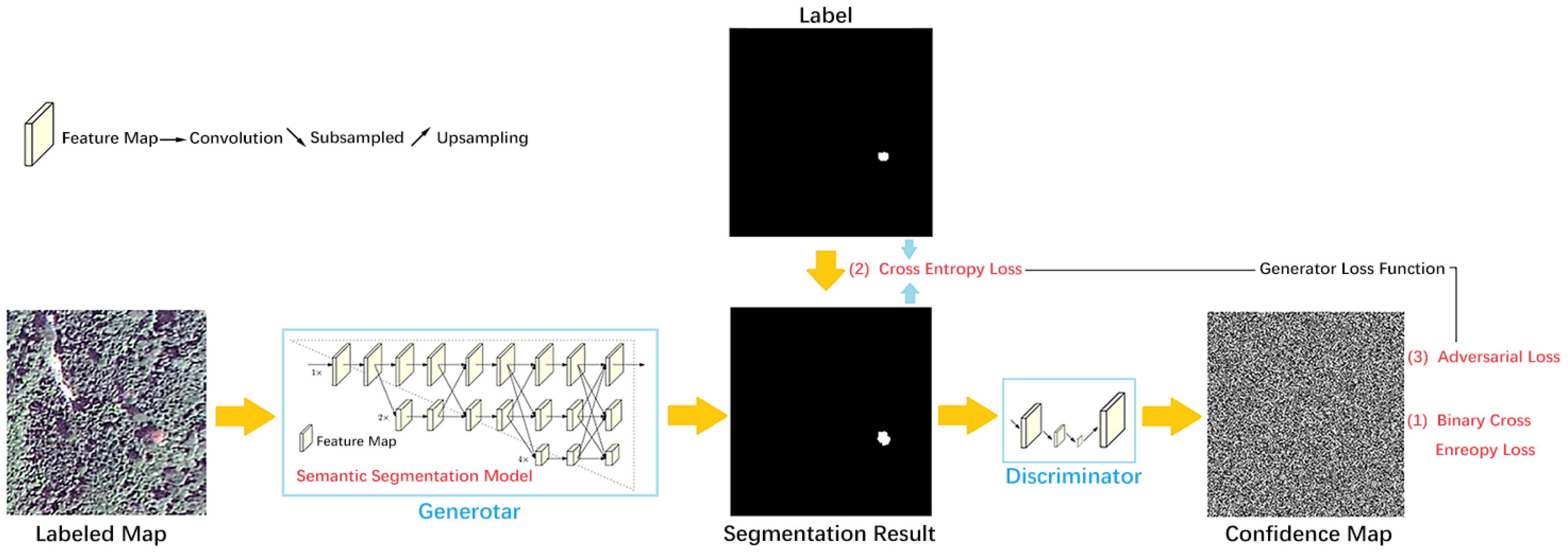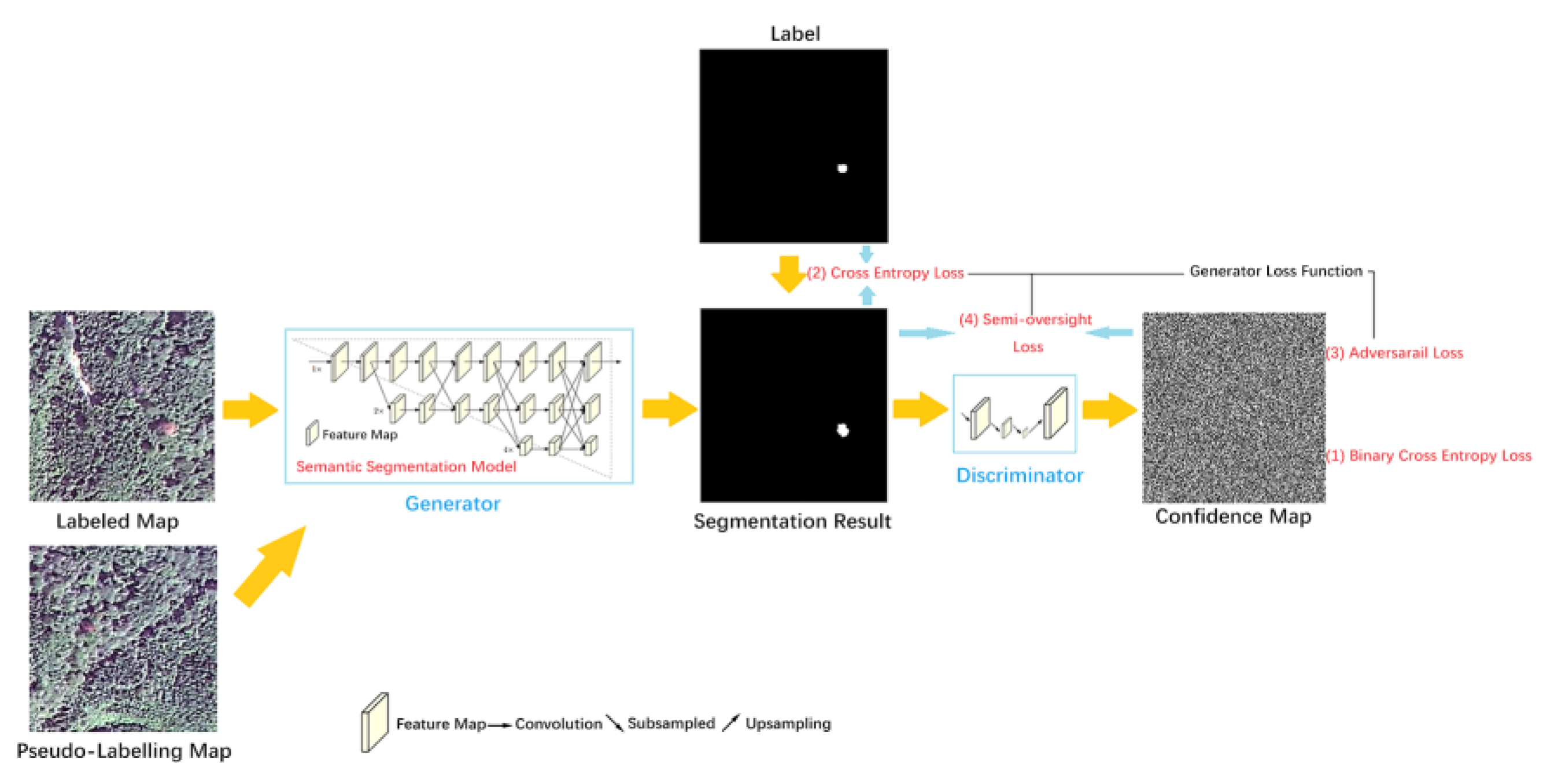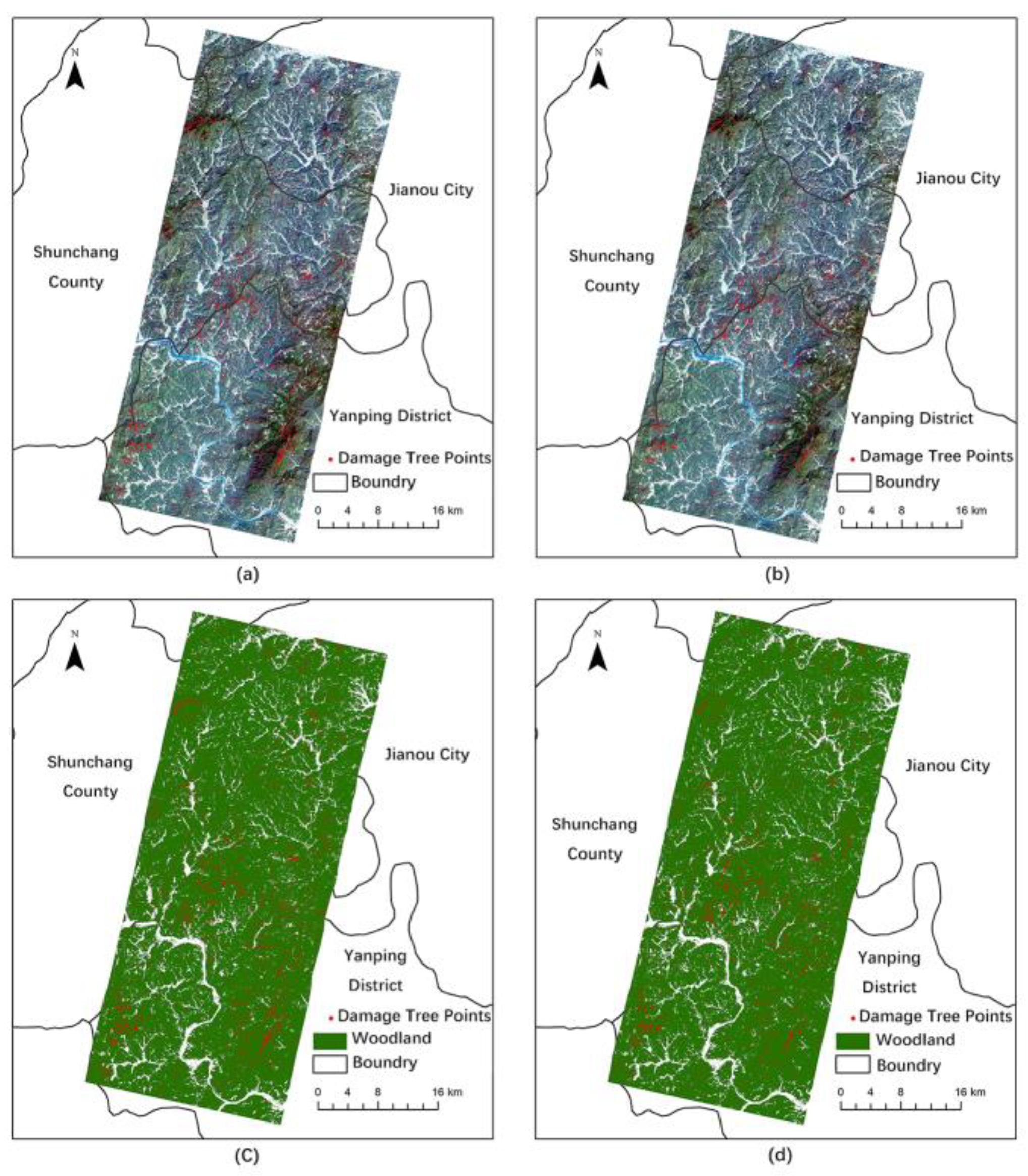Satellite Remote Sensing Identification of Discolored Standing Trees for Pine Wilt Disease Based on Semi-Supervised Deep Learning
Abstract
1. Introduction
2. Material and Methods
2.1. Study Area
2.2. Remote Sensing Image Data
2.3. Ground Survey Data and Woodland Distribution Data
2.4. Construction of a Semantic Segmentation Sample Dataset for PWD Discolored Standing Trees
2.5. Construction of the Deep Semantic Segmentation Model
2.6. Semi-Supervised Semantic Segmentation Model Construction Based on GANs
2.6.1. GAN-Based Supervised Semantic Segmentation Model
2.6.2. Semi-Supervised Semantic Segmentation Model Based on GAN
2.7. Semi-Supervised Semantic Segmentation Model Optimization Based on GANs
2.7.1. Model Macro Restructuring
2.7.2. Model Hyperparameter Optimization
2.8. Optimization and Evaluation of Discolored Standing Tree Identification Results of PWD
2.8.1. Swelling Prediction
2.8.2. Woodland Mask Extraction
2.8.3. Evaluation of Results
3. Results
3.1. Sample Dataset for Semantic Segmentation of PWD Based on Gaofen-2 Images
3.2. Analysis of Recognition Performance of Three Traditional Semantic Segmentation Models
3.3. Analysis of the Recognition Effect of the GAN-Based Semi-Supervised Semantic Segmentation Model
3.4. Optimization Results of the GAN-Based Semi-Supervised Semantic Segmentation Model
3.4.1. Analysis of Model Macrostructural Adjustment Results
3.4.2. Analysis of Model Hyperparameter Optimization Results
3.5. Identification Results of Gaofen-2 Remote Sensing Monitoring Application Demonstration of PWD
4. Discussion
5. Conclusions
Author Contributions
Funding
Data Availability Statement
Conflicts of Interest
References
- Mota, M.M.; Futai, K.; Vieira, P. Pine Wilt Disease and the Pinewood Nematode, Bursaphelenchus Xylophilus. In Integrated Management of Fruit Crops Nematodes; Springer: Dordrecht, The Netherlands, 2009; Volume 4, pp. 253–274. [Google Scholar]
- Robinet, C.; Van Opstal, N.; Baker, R.; Roques, A. Applying a spread model to identify the entry points from which the pine wood nematode, the vector of pine wilt disease, would spread most rapidly across Europe. Biol. Invasions 2011, 13, 2981–2995. [Google Scholar] [CrossRef]
- Wang, X.; Cao, Y.; Wang, L.; Pu, C.; Li, C. Occurrence and control status of pine wilt diseases. Nat. Enemies Insects 2018, 40, 256–267. [Google Scholar]
- Zhang, K.; Liang, J.; Yan, D.; Zhang, X. Research on pine wilt disease in China. World For. Res. 2010, 23, 59–63. [Google Scholar]
- Zhai, J.; Lu, L.; Chen, Y. Distribution characteristics and control ideas of pine wood nematode in Xiangshan County, Ningbo. China For. Sci. Technol. 1992, 04, 41–42. [Google Scholar] [CrossRef]
- Wang, X.; Wang, Q. A preliminary report on pine wilt diseases in Ma’anshan, Anhui province. Plant Quar. 1989, 260, 5–8. [Google Scholar]
- Fang, G.; Huang, W.; Mou, X.; Liu, H.; Zhou, H.; Zhang, J.; Zhang, B.; Li, X.; Chen, Y. Practice and prospect of precise monitoring of pine wilt diseases epidemic. For. Pest Dis. 2022, 41, 16–23. [Google Scholar]
- Jiang, M.; Huang, B.; Yu, X.; Zhen, W.; Jin, Y.; Liao, M. Distribution, damage and control measures of pine wilt disease. J. Zhejiang For. Sci. Technol. 2018, 38, 83–91. [Google Scholar]
- Ju, Y.; Pan, J.; Wang, X.; Zhang, H. Detection of Bursaphelenchus xylophilus infection in Pinus massoniana from hyperspectral data. Nematology 2014, 16, 1197–1207. [Google Scholar] [CrossRef]
- Lee, J.B.; Kim, E.S.; Lee, S.H. An analysis of spectral pattern for detecting pine wilt disease using ground-based hyperspectral camera. Korean J. Remote Sens. 2014, 30, 665–675. [Google Scholar] [CrossRef][Green Version]
- Kim, J.-B.; Jo, M.-H.; Kim, I.-H.; Kim, Y.-K. A Study on the Extraction of Damaged Area by Pine Wood Nematode Using High Resolution IKONOS Satellite Images and GPS. J. Korean Soc. For. Sci. 2003, 92, 362–366. [Google Scholar]
- Kim, J.-B.; Park, J.-H.; Jo, M.-H. A Spectral Characteristic Analysis of Damaged Pine Wilt Disease Area in IKONOS Image; Department of Urban Information Engineering, Kyungil University: Kyungbuk, Republic of Korea, 2000. [Google Scholar]
- Wang, Z.; Zhang, X.; An, S. Spectral characterization of Pinus sylvestris stands infested with pine wood nematode. Remote Sens. Technol. Appl. 2007, 03, 367–370. [Google Scholar]
- Lee, S.-H.; Cho, H.-K.; Lee, W.-K. Detection of The Pine Trees Damaged by Pine Wilt Disease using High Resolution Satellite and Airborne Optical Imagery. Korean J. Remote Sens. 2007, 23, 409–420. [Google Scholar]
- Kim, S.-R.; Lee, W.-K.; Lim, C.-H.; Kim, M.; Kafatos, M.C.; Lee, S.-H.; Lee, S.-S. Hyperspectral analysis of pine wilt disease to determine an optimal detection index. Forests 2018, 9, 115. [Google Scholar] [CrossRef]
- Kim, S.-R.; Kim, E.-S.; Nam, Y.; Choi, W.I.; Kim, C.-M. Distribution Characteristics Analysis of Pine Wilt Disease Using Time Series Hyperspectral Aerial Imagery. Korean J. Remote Sens. 2015, 31, 385–394. [Google Scholar] [CrossRef]
- Xu, P.; Zhou, X.; Yu, A. Sky-land integrated three-dimensional monitoring technology for pine wood nematode disease. Surv. Mapp. 2020, 43, 104–108. [Google Scholar]
- Zhang, B.; Ye, H.; Lu, W.; Huang, W.; Wu, B.; Hao, Z.; Sun, H. A Spatiotemporal Change Detection Method for Monitoring Pine Wilt Disease in a Complex Landscape Using High-Resolution Remote Sensing Imagery. Remote Sens. 2021, 13, 2083. [Google Scholar] [CrossRef]
- Bright, B.C.; Hudak, A.T.; Egan, J.M.; Jorgensen, C.L.; Rex, F.E.; Hicke, J.A.; Meddens, A.J.H. Using Satellite Imagery to Evaluate Bark Beetle-Caused Tree Mortality Reported in Aerial Surveys in a Mixed Conifer Forest in Northern Idaho, USA. Forests 2020, 11, 529. [Google Scholar] [CrossRef]
- Kim, J.-B.; Jo, M.-H.; Oh, J.-S.; Lee, K.-J.; Park, S.-J. Extraction Method of Dam-Aged Area by Pine Wilt Disease (Bursaphelenchus Xylophilus) Using Remotely Sensed Data and Gis. In Proceedings of the ACRS, 2001, 22nd Asian Conference on Remote Sensing, Singapore, 5–9 November 2001. [Google Scholar]
- Zhang, T. Research on Remote Sensing Monitoring and Prediction of Pine Wood Nematode Disease in Sanming, Fujian Province. Master’s Thesis, Beijing Forestry University, Beijing, China, 2010. [Google Scholar]
- Johnson, B.A.; Tateishi, R.; Hoan, N.T. A hybrid pansharpening approach and multiscale object-based image analysis for mapping diseased pine and oak trees. Int. J. Remote Sens. 2013, 34, 6969–6982. [Google Scholar] [CrossRef]
- Takenaka, Y.; Katoh, M.; Deng, S.; Cheung, K. Detecting forests damaged by pine wilt disease at the individual tree level using airborne laser data and worldview-2/3 images over two seasons. Int. Arch. Photogramm. Remote Sens. Spat. Inf. Sci. 2017, XLII-3/W3, 181–184. [Google Scholar] [CrossRef]
- Beck, P.S.; Zarco-Tejada, P.; Strobl, P.; San Miguel, J. The feasibility of detecting trees affected by the pine wood nematode using remote sensing. EUR—Sci. Tech. Res. Rep. 2015, 1831–9424. Available online: https://data.europa.eu/doi/10.2788/711975 (accessed on 8 October 2022).
- Olegario, T.V.; Baldovino, R.G.; Bugtai, N.T. A Decision Tree-based Classification of Diseased Pine and Oak Trees Using Satellite Imagery. In Proceedings of the 2020 IEEE 12th International Conference on Humanoid, Nanotechnology, Information Technology, Communication and Control, Environment, and Management (HNICEM), Manila, Philippines, 3–7 December 2020; pp. 1–4. [Google Scholar]
- Zhang, L.; Zhang, L.; Du, B. Deep learning for remote sensing data: A technical tutorial on the state of the art. IEEE Geosci. Remote Sens. Mag. 2016, 4, 22–40. [Google Scholar] [CrossRef]
- Li, W.; Hsu, C.-Y. Automated terrain feature identification from remote sensing imagery: A deep learning approach. Int. J. Geogr. Inf. Sci. 2020, 34, 637–660. [Google Scholar] [CrossRef]
- Zhang, C.; Sargent, I.; Pan, X.; Li, H.; Gardiner, A.; Hare, J.; Atkinson, P.M. Joint Deep Learning for land cover and land use classification. Remote Sens. Environ. 2019, 221, 173–187. [Google Scholar] [CrossRef]
- Lin, Z.; Ji, K.; Leng, X.; Kuang, G. Squeeze and Excitation Rank Faster R-CNN for Ship Detection in SAR Images. IEEE Geosci. Remote Sens. Lett. 2019, 16, 751–755. [Google Scholar] [CrossRef]
- Huang, J.; Lu, X.; Chen, L.; Sun, H.; Wang, S.; Fang, G. Accurate Identification of Pine Wood Nematode Disease with a Deep Convolution Neural Network. Remote Sens. 2022, 14, 913. [Google Scholar] [CrossRef]
- Zhou, H.; Yuan, X.; Zhou, H.; Shen, H.; Ma, L.; Sun, L.; Fang, G.; Sun, H. Surveillance of pine wilt disease by high resolution satellite. J. For. Res. 2022, 33, 1401–1408. [Google Scholar] [CrossRef]
- Hu, J. Discussion on the prevention and control of pine wilt nematode in Chun’an County. East China For. Manag. 2020, 34, 32–34. [Google Scholar]
- Pan, T.; Yu, C.; Xu, G. Thousand island lake area pine nematode disease prevention and control analysis. Prot. For. Sci. Technol. 2019, 02, 90–92. [Google Scholar]
- Chen, L.-C.; Zhu, Y.; Papandreou, G.; Schroff, F.; Adam, H. Encoder-Decoder with Atrous Separable Convolution for Semantic Image Segmentation. In Proceedings of the European Conference on Computer Vision (ECCV), Munich, Germany, 8–14 September 2018; pp. 833–851. [Google Scholar]
- Goodfellow, I.J.; Pouget-Abadie, J.; Mirza, M.; Xu, B.; Warde-Farley, D.; Ozair, S.; Courville, A.; Bengio, Y. Generative Adversarial Networks. arXiv 2014, arXiv:1406.2661. [Google Scholar] [CrossRef]
- Hung, W.-C.; Tsai, Y.-H.; Liou, Y.-T.; Lin, Y.-Y.; Yang, M.-H. Adversarial Learning for Semi-Supervised Semantic Segmentation. arXiv 2018, arXiv:1802.07934. [Google Scholar]
- Masters, D.; Luschi, C. Revisiting small batch training for deep neural networks. arXiv 2018, arXiv:1804.07612. [Google Scholar]
- McCandlish, S.; Kaplan, J.; Amodei, D.; Team, O.D. An empirical model of large-batch training. arXiv 2018, arXiv:1812.06162. [Google Scholar]
- Sun, K.; Xiao, B.; Liu, D.; Wang, J. Deep High-Resolution Representation Learning for Human Pose Estimation. In Proceedings of the IEEE/CVF Conference on Computer Vision and Pattern Recognition, Long Beach, CA, USA, 15–20 June 2019; pp. 5693–5703. [Google Scholar]
- Park, H.G.; Yun, J.P.; Kim, M.Y.; Jeong, S.H. Multichannel Object Detection for Detecting Suspected Trees With Pine Wilt Disease Using Multispectral Drone Imagery. IEEE J. Sel. Top. Appl. Earth Obs. Remote Sens. 2021, 14, 8350–8358. [Google Scholar] [CrossRef]





| Province | Numbers /Scenes | Resolution/m | Cloud Percent /% | Receive Time | Coverage Area /km2 |
|---|---|---|---|---|---|
| Hubei | 3 | 1 m | <5 | 2018.10.04 | 1193.87 |
| Fujian | 3 | 1 m | <5 | 2019.09.19 | 1229.23 |
| Zhejiang | 2 | 1 m | <5 | 2022.05.12 | 770.58 |
| Jiangxi | 13 | 1 m | <5 | 2019.09.24 | 4162.13 |
| DeepLabv3+ | HRNet | DANet | |
|---|---|---|---|
| MIoU (%) | 55.55 | 66.33 | 58.43 |
| Parameters | 41,253,618 | 17,066,874 | 71,730,442 |
| Convergence rate (time) | 28 | 34 | 13 |
| Training time (s) | 29,686 | 46,824 | 71,859 |
| HRNet | GAN_HRNet | GAN_HRNet_Semi | |
|---|---|---|---|
| MIoU (%) | 65.26 | 66.55 | 68.36 |
| Parameters | 17,066,874 | 17,599,749 | 17,599,749 |
| Convergence rate (time) | 23 | 46 | 48 |
| Training time (s) | 9846 | 13,580 | 15,809 |
| Start Structure | Structure Adjustment 1 | Structure Adjustment 2 | |
|---|---|---|---|
| MIoU (%) | 68.36 | 67.82 | 64.27 |
| Parameters | 17,599,749 | 17,267,845 | 19,830,597 |
| Convergence rate (time) | 48 | 40 | 50 |
| Training time (s) | 15,809 | 26,979 | 15,773 |
| bt2 | bt4 | |
|---|---|---|
| MIoU (%) | 70.42 | 68.36 |
| Parameters | 17,599,749 | 17,599,749 |
| Convergence rate (time) | 23 | 48 |
| Training time (s) | 18,899 | 15,809 |
| 1.0 × 10−1 | 1.0 × 10−2 | 1.0 × 10−3 | 1.0 × 10−4 | 1.5 × 10−5 | 1.0 × 10−5 | |
|---|---|---|---|---|---|---|
| MIoU (%) | 61.11 | 71.68 | 72.02 | 71.44 | 70.42 | 69.41 |
| Parameters | 17,599,749 | 17,599,749 | 17,599,749 | 17,599,749 | 17,599,749 | 17,599,749 |
| Convergence rate (time) | N/A | 48 | 23 | 40 | 23 | 49 |
| Training time (s) | 18,315 | 18,576 | 18,953 | 18,935 | 18,899 | 18,720 |
| Inflation Prediction | Inflation Prediction + Extract by Woodland | |
|---|---|---|
| Manual labeled (number) | 2596 | 2586 |
| Model prediction (number) | 3010 | 2975 |
| Correct identification (number) | 2080 | 2071 |
| Precision (%) | 69.10 | 69.61 |
| Recall (%) | 80.12 | 80.09 |
| F1-score (%) | 74.20 | 74.48 |
Publisher’s Note: MDPI stays neutral with regard to jurisdictional claims in published maps and institutional affiliations. |
© 2022 by the authors. Licensee MDPI, Basel, Switzerland. This article is an open access article distributed under the terms and conditions of the Creative Commons Attribution (CC BY) license (https://creativecommons.org/licenses/by/4.0/).
Share and Cite
Wang, J.; Zhao, J.; Sun, H.; Lu, X.; Huang, J.; Wang, S.; Fang, G. Satellite Remote Sensing Identification of Discolored Standing Trees for Pine Wilt Disease Based on Semi-Supervised Deep Learning. Remote Sens. 2022, 14, 5936. https://doi.org/10.3390/rs14235936
Wang J, Zhao J, Sun H, Lu X, Huang J, Wang S, Fang G. Satellite Remote Sensing Identification of Discolored Standing Trees for Pine Wilt Disease Based on Semi-Supervised Deep Learning. Remote Sensing. 2022; 14(23):5936. https://doi.org/10.3390/rs14235936
Chicago/Turabian StyleWang, Jiahao, Junhao Zhao, Hong Sun, Xiao Lu, Jixia Huang, Shaohua Wang, and Guofei Fang. 2022. "Satellite Remote Sensing Identification of Discolored Standing Trees for Pine Wilt Disease Based on Semi-Supervised Deep Learning" Remote Sensing 14, no. 23: 5936. https://doi.org/10.3390/rs14235936
APA StyleWang, J., Zhao, J., Sun, H., Lu, X., Huang, J., Wang, S., & Fang, G. (2022). Satellite Remote Sensing Identification of Discolored Standing Trees for Pine Wilt Disease Based on Semi-Supervised Deep Learning. Remote Sensing, 14(23), 5936. https://doi.org/10.3390/rs14235936







